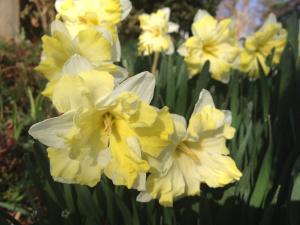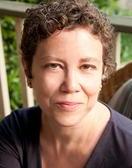
Every year, I find myself trying to explain how a nice Jewish girl can relate to Easter. Today, the spring sunshine is illuminating the daffodils, as you can see in this photo from my garden. I had an entirely crazy week, including an appearance on the Today Show, gathering in Boston with my Jewish and Catholic and Protestant family at the start of Passover, and then arriving back home just in time for our interfaith families community Easter service. But I had such a lovely Easter, I feel I need to describe once again how being in a room filled with hundreds of interfaith families, in a service led by a minister and a rabbi working closely together, can be a transcendent experience.
Years ago, before the Interfaith Families Project began holding Easter services, my husband and I went to various churches during Holy Week. He was glad to hear familiar hymns. I was vaguely uncomfortable with gospel readings that did not acknowledge the Jewishness of Jesus or put the role of “the Jews” in this traumatic story into any kind of historical perspective. In general, this can be the hardest week for Jews to accompany their Christian spouses or other family members to church.
Instead, this morning, we entered a space filled with couples holding hands, and babies, and toddlers in Easter finery, and visiting grandparents: all families raising interfaith children with interfaith education. As it turned out, every song we sang had interfaith connections, whether or not the community was aware of it. We sang “Morning Has Broken” (a hymn adapted by Cat Stevens, who later became a Muslim) and “Prepare Ye” from Godspell (a show with lyrics adapted by the Jewish Stephen Schwartz, from the Episcopal Book of Common Prayer), and “Let My People Go” (an Exodus text beloved by Jews and adapted by African-American Christians). We told the story of Holy Week in part through singing verses of “Lord of the Dance,” a Shaker tune adapted by British poet Sydney Carter to tell the story of Jesus: “They buried my body and they thought I was gone, But I am the dance and I still go on.” Carter admitted that his lyrics were inspired in part by a statue of Shiva, the dancing Hindu god, he kept on his desk. And in Carter’s obituary, the Telegraph noted that the hymn contains “a hint of paganism which, mixed with Christianity, makes it attractive to those of ambiguous religious beliefs or none at all.” Well, so, yes, that is me, and many of the people in my interfaith families community. But I would also note that the hymn is used widely in Christian churches and communities (many of them filled, to be honest, with people with ambiguous religious beliefs themselves).
The point here is not that we do or do not subscribe to a particular Christian creed or dogma. The point is that many of us are spiritually inspired, and often deeply moved, by the religious interconnections that led to the creation of these songs, and to the opportunity to sing them together with other interfaith families in a room filled with people from many races, cultures, religions, and worldviews.
Meanwhile, I sit facing my beloved rabbi, Harold White, on the eve of his retirement. And I see him, arm and arm with Reverend Julia Jarvis, his partner as spiritual leaders of our community. He is singing along with gusto, celebrating both the Kumbaya songs (for really, must we always mock the lovely spiritual that is Kumbaya?) and the more specific Christology of the iconic Protestant hymn, “Christ The Lord is Risen Today.” Sitting next to me, my husband gets the chance to boom out the harmonies in his rich baritone, harmonies learned in his youth as an acolyte.
But the rabbi? How can a rabbi sing “Death in vain forbids Christ rise”? So, here is how our rabbi helped us, a community of Jews and Christians and atheists and Buddhists, to understand the symbolism of Easter, this year. He told a parable of a King who sends his son, a Prince, to live with peasants to understand the reality of suffering in the world. When he calls the Prince back to the palace, the peasants are sad and do not want to let him go. Obviously this sounds like God sending Jesus to earth, and then calling him back. But the rabbi’s point was that the Prince represents the soul, and that every soul that must be embodied in order to experience the reality of life. But ultimately this is a temporary condition, and at death the soul rises, or if you will, from a more secular perspective, the energy of life is transformed and merges back into the energy of the rest of the universe. Every religion has some way of explaining this transformation from life into death, and the idea that the soul or energy is somehow conserved or cyclical in nature. The story of the life and death and resurrection of Jesus is one version of this universal story.
Susan Katz Miller’s book, Being Both: Embracing Two Religions in One Interfaith Family is available now in hardcover, paperback and eBook from Beacon Press.

